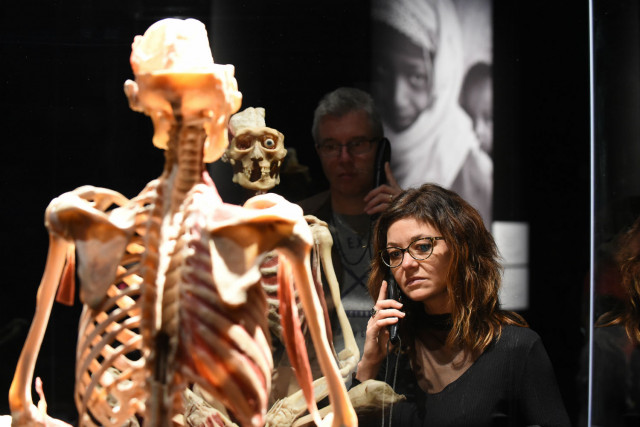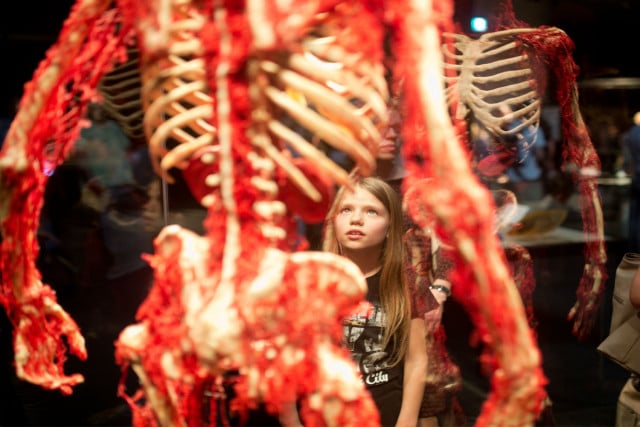Life in corpses: Behind the scenes of 'Body Worlds' in Ulm

Hidden inside a shopping mall in Ulm, Baden-Württemberg, the new Body Worlds exhibit is a startling look at life - even from the vantage point of death.
“I do love a fireman” whispers the press officer to me with a wink. I look at the specimen before us kitted out in a New York City Fire Department helmet. He stares glassily back.
“Even without his skin?” I ask. The sound of a beating heart throbs out of a speaker above us. Fut-fut. Fut-fut. The sound of life. The press officer laughs.
I can see the fireman’s stringy red muscles knitted intricately together. I can see the organs in his chest – his lungs like a swallowed set of wings. His eyelashes are visible when I get up close - a disarmingly human detail.
'We don't want the exhibits to look scary'
For the last 20 years, married couple Professor Gunter von Haagens (born in 1945 in former Thuringia) and Dr Angelina Whalley (born in Hanover in 1960) have been collecting, preparing and displaying specimens like the fireman to audiences around the world.

von Haagans and Whalley at the Ulm exhibit. Photo courtesy of Désirée Müller.
The purpose? To show us in vivid detail how the human body works and how our lifestyles can either nourish or damage it. A new version of the exhibition, Body Worlds: A heartfelt thing opened this spring at the Blautal Shopping Centre in Ulm, Baden-Württemberg.
“The bodies in our exhibition may be dead, but in them we see life – and a shopping centre is a place where life happens," explains Whalley, who completed her medical studies at Heidelberg University.
In 2009, German politicians called for the exhibition to be withdrawn, lambasting it as “disgusting”, while one art critic in London labelled it “a Victorian freak show”.
SEE ALSO: Controversial Body Worlds show comes to Berlin
Facing the criticism, Whalley admits, was challenging at first. Two decades and over 40 million visitors later however, she has evidently toughened up.
Defending the decision to show the bodies in lifelike poses she says: “We don’t want the exhibits to look scary. If we want to show their scientific value, we have to allow the observer to get up close – and by the way, the anatomists of the Renaissance period did the same”.
For some people, visiting Body Worlds is life altering. Whalley recalls watching a young Japanese woman breaking down in tears when the exhibition came to Tokyo.
“She had previously tried to take her own life on three occasions because she’d always felt worthless. She said the exhibition made her realise she actually had something wonderful inside her, and would never harm herself again”.

Photo courtesy of Désirée Müller.
More than 18,000 donors around the world
Everything in the exhibition – from the brains, to the blood vessels – comes from what was once a real person. More than 18,000 people from around the world are currently registered as donors.
After death, the bodies are handed over to Von Haagens and Whalley, who halt the decomposition process using a technique called plastination, invented by the professor in the 1970s.
The process, whereby the body’s fluids are drained and replaced with a special chemical, takes a painstaking 1500 hours. Whether a donor will later be portrayed as an ice dancer, a gymnast or a chess player however, is another matter.
“I can’t guarantee that someone who rode a motorbike in life will be shown sitting on a motorbike in the exhibition. It depends on the condition of the body and the diseases the individual may have suffered during their lifetime” says Whalley.

Photo courtesy of Désirée Müller.
'We don't want the exhibits to look scary'
These days our bodies bend to the screeching pitch of technology. Our hearts – what the exhibition calls “the engine of life” - pulse to the erratic rhythm of competing demands on our attention.
Social media presents our bodies as something to be mastered, beaten, tamed – something subject to the approval of others, rather than simply being valuable in itself.
Perhaps that’s why Body World continues to attract visitors after so many years on the road; as a welcome reminder of what our bodies are capable of, simply by having a beating heart.
Body Worlds: A Heartfelt thing is currently on display at the Blautal Shopping Centre in Ulm, Baden-Württemberg. The exhibition closes on May 1st, 2019.
Comments
See Also
“I do love a fireman” whispers the press officer to me with a wink. I look at the specimen before us kitted out in a New York City Fire Department helmet. He stares glassily back.
“Even without his skin?” I ask. The sound of a beating heart throbs out of a speaker above us. Fut-fut. Fut-fut. The sound of life. The press officer laughs.
I can see the fireman’s stringy red muscles knitted intricately together. I can see the organs in his chest – his lungs like a swallowed set of wings. His eyelashes are visible when I get up close - a disarmingly human detail.
'We don't want the exhibits to look scary'
For the last 20 years, married couple Professor Gunter von Haagens (born in 1945 in former Thuringia) and Dr Angelina Whalley (born in Hanover in 1960) have been collecting, preparing and displaying specimens like the fireman to audiences around the world.

von Haagans and Whalley at the Ulm exhibit. Photo courtesy of Désirée Müller.
The purpose? To show us in vivid detail how the human body works and how our lifestyles can either nourish or damage it. A new version of the exhibition, Body Worlds: A heartfelt thing opened this spring at the Blautal Shopping Centre in Ulm, Baden-Württemberg.
“The bodies in our exhibition may be dead, but in them we see life – and a shopping centre is a place where life happens," explains Whalley, who completed her medical studies at Heidelberg University.
In 2009, German politicians called for the exhibition to be withdrawn, lambasting it as “disgusting”, while one art critic in London labelled it “a Victorian freak show”.
SEE ALSO: Controversial Body Worlds show comes to Berlin
Facing the criticism, Whalley admits, was challenging at first. Two decades and over 40 million visitors later however, she has evidently toughened up.
Defending the decision to show the bodies in lifelike poses she says: “We don’t want the exhibits to look scary. If we want to show their scientific value, we have to allow the observer to get up close – and by the way, the anatomists of the Renaissance period did the same”.
For some people, visiting Body Worlds is life altering. Whalley recalls watching a young Japanese woman breaking down in tears when the exhibition came to Tokyo.
“She had previously tried to take her own life on three occasions because she’d always felt worthless. She said the exhibition made her realise she actually had something wonderful inside her, and would never harm herself again”.

Photo courtesy of Désirée Müller.
More than 18,000 donors around the world
Everything in the exhibition – from the brains, to the blood vessels – comes from what was once a real person. More than 18,000 people from around the world are currently registered as donors.
After death, the bodies are handed over to Von Haagens and Whalley, who halt the decomposition process using a technique called plastination, invented by the professor in the 1970s.
The process, whereby the body’s fluids are drained and replaced with a special chemical, takes a painstaking 1500 hours. Whether a donor will later be portrayed as an ice dancer, a gymnast or a chess player however, is another matter.
“I can’t guarantee that someone who rode a motorbike in life will be shown sitting on a motorbike in the exhibition. It depends on the condition of the body and the diseases the individual may have suffered during their lifetime” says Whalley.

Photo courtesy of Désirée Müller.
'We don't want the exhibits to look scary'
These days our bodies bend to the screeching pitch of technology. Our hearts – what the exhibition calls “the engine of life” - pulse to the erratic rhythm of competing demands on our attention.
Social media presents our bodies as something to be mastered, beaten, tamed – something subject to the approval of others, rather than simply being valuable in itself.
Perhaps that’s why Body World continues to attract visitors after so many years on the road; as a welcome reminder of what our bodies are capable of, simply by having a beating heart.
Body Worlds: A Heartfelt thing is currently on display at the Blautal Shopping Centre in Ulm, Baden-Württemberg. The exhibition closes on May 1st, 2019.
Join the conversation in our comments section below. Share your own views and experience and if you have a question or suggestion for our journalists then email us at [email protected].
Please keep comments civil, constructive and on topic – and make sure to read our terms of use before getting involved.
Please log in here to leave a comment.